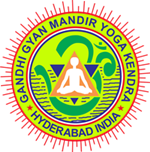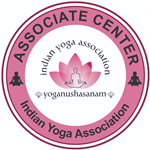It is very convenient to practice asanas lying on the abdomen. But people with abdominal problems of prolonged diseases like ulcer, hernia, fibroids, prostate enlargements, appendicitis etc. must follow the prescribed instructions strictly for each asan.
- 1. Shithilasan
- 2. Nabhi asan
- 3. Bhujangasan
- 4. Niralambasan or Makarasan
- 5. Shalabhasan
- 6. Dhanurasan
- 7. Aakarna dhanurasan
- 8. Vipareet Merudandasan
- 9. Vipareet Pavan muktasan
1. Shithilasan:
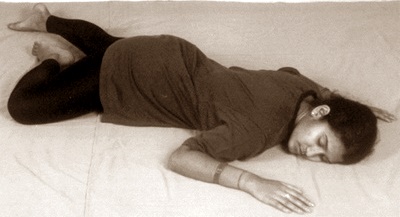
The entire body is let loose (Shithil = loose) in this asan, so it got its name as Shithilasan.
Procedure:
Lying on the stomach, place the hands comfortably on the floor near the face. Turn the head right. Bend the right leg a little keeping the left leg straight. The entire body should be let loose, the eyes closed. Breathe slowly.
After a while, turn head to left changing the legs inverse. Entire body is let loose as above.
Awareness:
Each part of the body, from head to toes, gradually loosening part by part.
Note: After practicing each of the following asanas lying on the abdomen, the practitioner should relax for some time in this Shithilasan compulsorily.
Advantages:
This asan provides rest to all the parts of the body. Tiredness is reduced. Tension is relaxed. It benefits people suffering from heart diseases and blood pressure. It sends the practitioner into sound sleep.
“Shithilasan to provide rest to all the parts of the body”.
2. Nabhi asan:

Entire body rests on the navel (Nabhi), so it is popular with this name.
Procedure:
This is the reverse asan of Naukasan.
Lying on the abdomen, stretch both the hands straight. Join the palms in the namaskar posture. Stretch both the legs straight joining the heels. Breathing in, raise both the hands, legs, head and chest simultaneously to their maximum possible height. Rest the entire weight of the body on stomach and navel.
After being in this state for 5 to 10 seconds, relax the body to normal position breathing out. Repeat it 3 to 5 times.
If it is not possible to lift both the hands and both the legs together, then one hand and one leg may be raised alternatively in the initial stage.
Awareness:
Navel / abdomen
Advantages:
It strengthens the navel and other parts of the stomach. If the navel is dislocated from its point, many complications arise. This exercise keeps the navel in its proper place. Hands, legs and chest are empowered.
Prohibition:
People who have had stomach operation in the recent past, people suffering from hernia and ulcer, pregnants should not attempt this exercise.
“Nabhi asan to energize the navel”
3. Bhujangasan:
This asan resembles the hooded snake (=bhujang), so it got its name thus.
Generally, while we work our head is bent forward. So we may suffer from neck pains and spondylitis. In Bhujangasan, the head is turned back so there is no chance for getting neck pains.
There are a few variations. Each may be repeated 2 to 5 times.
Procedure:
1. Lying on the stomach, stretch the total body straight. Join the toes and heels of both the feet together. Bring both the palms to the sides of the chest. Breathing in, raise the upper body resting on both the forearms. Head is raised looking up. After a while, breathing out, bring the body slowly down to the normal position on the floor.
Awareness:
Neck
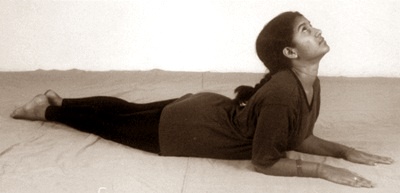
2. As above, breathing in, raise the forearms also along with the chest. Breathing out, bring the hands and head down.
Awareness:
Both sides of the neck

3. Place both the palms on the floor near the chest. Pressing the floor with the palms, breathing in, lift the head, chest and stomach including navel and look up. Breathing out, bring the body back to normal position.
Awareness:
Shoulders
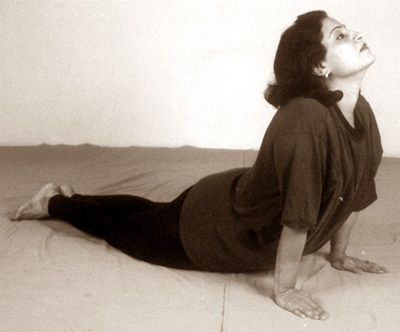
4. Place both the hands on back of the neck interlocking the fingers. Breathing in, raise chest, head and the elbows up to the maximum extent. Breathing out, bring the body down.
Awareness:
Neck
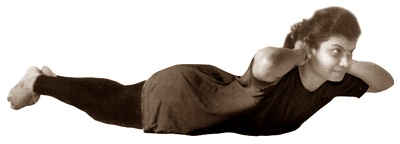
5. a. Stretch both the hands sidewise. Raise the right hand up. Breathing in, raise the head, and look at the raised right hand. Breathing out, bring down the body back to normal position.
Awareness:
Chest : Rightside
b. Repeat the same exercise raising left hand.
Awareness:
Chest : Leftside
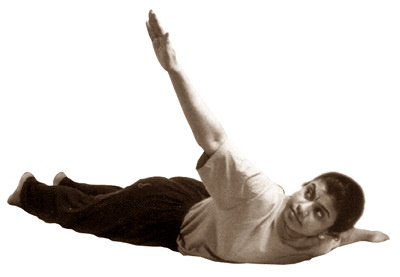
c. Breathing in, raise both the hands, chest and head to the maximum possible height. Breathing out, bring the body to normal position.
Awareness:
Chest : Full
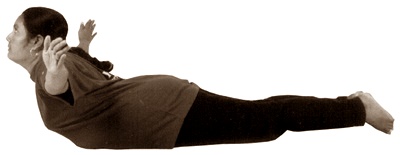
6. Place both the hands on the back, holding one wrist with the other hand. Stretch the hands behind. Breathing in, raise the chest and head and look up. Breathing out, come down to normal position.
Awareness:
Back, backbone, waist
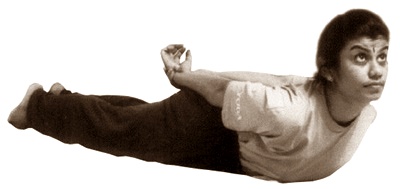
Advantages:
Memory power is increased. This asan is very useful for students. Spondylitis and other problems of neck to waist are controlled. Chest, heart, lungs and the backbone are strengthened. Night semen (male) discharges are controlled. Uterus (female) is cleaned. Menstrual cycle is regularized.
Prohibition:
People suffering from hernia, ulcer, appendicitis and pregnants are advised not to attempt this asan.
“Bhujangasan to control neck and waist pain”
4. Niralambasan or Makarasan:
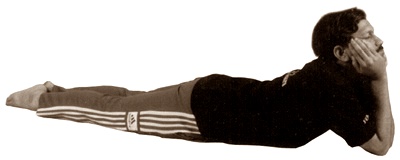
The posture in this asan looks like a crocodile (=makar) in water, so it got its name as Makarasan. This asan is an extension of Bhujangasan.
Procedure:
Lying on abdomen, raise the head and chest. Join both the palms and place them under the chin keeping the elbows together. Press gently, the jaws and cheeks with the palms resting the elbows on the floor. With normal breathing, keep the eyes closed. Be in the posture for about two minutes. Later take away the palms from the chin and bring the head down, to relax.
Awareness:
Back of neck while inhaling and lower back while exhaling
Advantages:
The day should begin with this asan performing it in the bed itself as soon as you get out of the sleep. Compositors in printing press, typists, computer operators, teachers, accountants, tailors, goldsmiths, readers etc. have to do this asan every day before they take their night meals also. This asan keeps the practitioners away from all neck and back problems. It helps to prevent and cure spondylitis and neck pains.
“Niralambasan prevents spondylitis”
5. Shalabhasan:
The position in this asan resembles a grass hopper (=shalabh).
Procedure:
1. Lying on the stomach, place both the hands under the thighs. Breathing in, raise the right leg. Hold the breath and leg for some time. Then gradually breathing out, bring the leg down. Chin should rest on the floor. Eyes are closed. Knees are not bent.
2. Similarly, raise left leg and repeat the process.
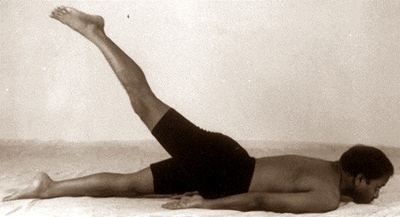
3. Later inhaling, raise both the legs without bending the knees. Hold up for some time. Exhaling, bring down both the legs. This is one round. Repeat 2 to 3 such rounds.
Awareness:
Stomach
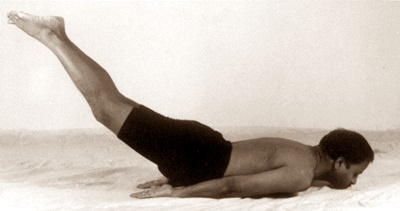
Advantages:
This exercise keeps away constipation. Small and large intestines are cleaned. Diabetes and sciatica pain are reduced. Pancreas is activated to function well.
Prohibition:
People suffering from severe stomach ache should not do this exercise.
“Shalabhasan strengthens the lower abdomen”
6. Dhanurasan:
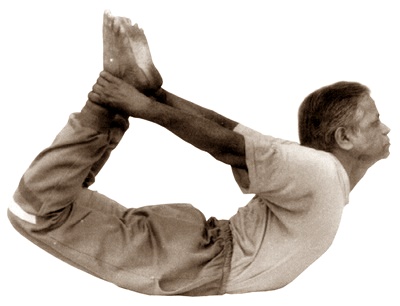
The body is turned like a bow (=Dhanush) in this asan, so it is called Dhanurasan.
Procedure:
Lying on the stomach, stretch the legs. Bend up the legs towards the buttocks. Hold both the ankles with both the hands. Breathing in, raise head, chest, thighs, knees, legs and hands. After being in that state for a while, breathing out bring the body slowly to normal position. There must be a distance of one foot between the legs.
After practicing three to four times, then holding the above bow position, move the body frontward and backward 5 to 10 times according to your capacity. Later swing the body 5 to 10 times from left to right and right to left.
Awareness:
Abdomen / backbone
Advantages:
This is a complementary to Bhujangasan and Shalabhasan. All the benefits of the above two asans are derived from this asan. This is very beneficial to women. Problems of uterus, urinary parts and problems arising during their menstrual periods are reduced. The glands are strengthened. Waist becomes slim. The excess fat accumulated in the stomach and hips is reduced.
Note: People with over weight, cannot hold the legs in the beginning. They have to tie pieces of cloth to their legs and these pieces of cloth can be held and practiced. Gradually with the help of cloth, ankles can be reached.
Prohibition:
People suffering from severe waist & backbone pain, ulcer, hernia, heart trouble, blood pressure and pregnants and weak should not attempt this asan. Persons having operated in the stomach during recent past, are also advised not to do this asan.
“Dhanurasan strengthens the back bone and reduces excess fat”
7. Aakarna dhanurasan:
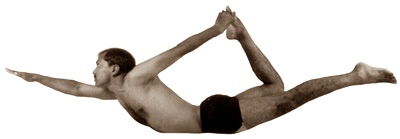
All the positions of Nabhiasan, Bhujangasan, Shalabhasan and Dhanurasan are embibed in Aakarna dhanurasan.
Procedure:
Lying on the stomach, join the legs and stretch the hands forward. Fold the left leg up and hold the left ankle with right hand. Breathing in, raise legs, hands, head and chest to their maximum.
Being in that state for a while, breathing out, slowly bring the body down to the normal position. Repeat it 2 to 3 times.
Later change the legs and hands and repeat 2 to 3 times.
Awareness:
Abdomen
Advantages:
All the benefits of the above mentioned four asans are derived from this asan.
“Aakarna dhanurasan strengthens neck, chest and waist”
8. Vipareet Merudandasan:
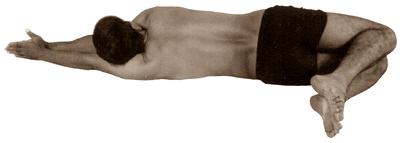
It is the reverse of the Merudandasan practiced lying on the back, so it got its name.
Procedure:
Lying on the abdomen, stretch both the hands into namaskar position. Join both the heels together and fold the legs upwards. Sway the body from left to right and from right to left. Breathing is normal.
Awareness:
Swaying of the body
Advantages:
The backbone is strengthened. The excess fat in the stomach is reduced. Back pain is prevented.
“Vipareet Merudandasan benefits the backbone”
9. Vipareet Pavan muktasan:

This is the reverse of the Pavan muktasan which is practiced lying on the back. This is practiced lying on the stomach. So it got its name as Vipareet Pavan muktasan.
Procedure:
1. Lying on the stomach, place both the hands under the shoulders on the floor firmly. Breathing in, raise the head and chest. Fold the right leg below the chest. Breathing out, touch the right knee with the chin. Breathing in, raise the head and stretch the right leg, back to normal position.
2. Similarly, repeat the exercise by folding left leg.
3. Later, bend both the knees below the chest. Breathing out, try to place the forehead on the floor between the knees. Hips are on the heels.
Exercises 1,2 and 3 form one round. Practice 2 to 3 such rounds.
Awareness:
Abdomen
Advantages:
All the benefits of Pavan muktasan are gained by this asan. Constipation, gastric trouble and acidity are reduced. Stomach is felt light. Digestion improves.
“Vipareet Pavan muktasan eradicates gastric troubles”
![]()
All the parts of the body are relaxed and empowered by the above asanas practiced in lying on the abdomen position. These exercises can be completed within few minutes. All can get benefits by practicing them according to their strength and capacity, following the prohibitions as mentioned.
![]()
